Canadian Line Materials
| Canadian Line Materials, LTD. | |
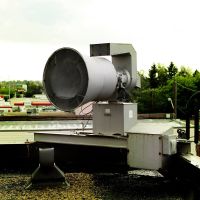
| |
| Names | Canadian Line Materials, LTD. |
|---|---|
| Headquarters | Scarborough, ON |
| Founded | 1925 |
| Defunct | 1985 |
| Products | Steelwork
Electrical equipment Outdoor warning sirens
|
Canadian Line Materials, LTD. (CLM) was a steel manufacturing company based in Scarborough, Ontario. Founded in 1925 as a division of McGraw-Edison, they produced a wide variety electrical equipment before being contracted by the Canadian government to manufacture air raid sirens for civil defense. Once common across Canada, these sirens are now very rare, though they remain a staple of the nation's Cold War history.
History
CLM started off in 1925 as a small steelwork company in Scarborough, Ontario, part of the larger McGraw-Edison company, producing electrical equipment such as lightning arresters. CLM was commissioned by the Canadian government to create air raid sirens for civil defense. CLM made several different sirens, both rotational and omnidirectional.
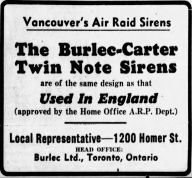
CLM originally used siren designs from another company known as Burlec-Carter. Ltd. (and often just Burlec, Ltd.), and later produced their own designs. Burlec-Carter was a company based out of Toronto, ON. Burlec's original siren designs were created in 1942 after the Canadian federal government contracted the Northern Electric Company to create 75 5-horsepower single tone sirens for Civil Defense use in the province of British Columbia. The B.C. provincial government wanted dual tone sirens instead, believing them to be more effective. After 28 single tone sirens were delivered (but not installed) the federal government finally listened to the province, dropped the contract with Northern Electric, and contracted Burlec to create dual tone sirens for the province. Many of these were installed in the Vancouver area, and were advertised as the "Burlec-Carter Twin Note Sirens", based directly on designs used in the UK. Burlec-Carter vanished from records in 1943, after its executives left the Prices Board to focus on other business. However, the Burlec name remained registered until 1981. Burlec's sirens would later be sold by CLM under the Type 5261, Type 5263 and Type 5223 names. Several also found their way to Ontario, with a 20/24 port Burlec-Carter known to have been installed in St. Catharines, ON in 1943.
All CLMs were designed with the harsh Canadian winter in mind, and as such, measures were taken to protect them from the elements. All CLM siren controllers were equipped with a special mode that would operate the siren's rotors at all times at a very low speed, between 60-75 RPM, in order to prevent ice from building up and potentially jamming the rotors and burning up the motor. All CLM sirens use directional rotors, which allows the siren increased performance as long as the rotors are spinning in the right direction. Reverse wired three phase units have slightly worse performance than a correctly wired unit.
Various models of CLMs were installed across Canada during the 1950s and 1960s alongside electric BNCO Mobil Directo BN44E sirens, especially in larger cities like Toronto and Ottawa, ON. After the Cold War, all of these sirens were decommissioned as there was no more use for them, and it was found that many of the controllers were prone to malfunctions as they aged. As most of Canada historically has not experienced severe weather like tornadoes frequently enough to warrant them, sirens do not have as much of a presence there. A few civil defense CLM siren units still sit on top of poles and rooftops, rotting away and abandoned, while others have found their homes in museums and private collections. A handful of CLMs have been refurbished and put back into service as fire sirens. These include a 20/24 port Type 5223 unit in Alvinston, ON, two Type 5261 CLM fire siren variants in Port Lambton, ON and Qualicum Beach, BC, and a single active rotational CLM used as a fire siren in Alliance, AB.[1]
CLM itself was eventually acquired by Cooper Industries and ceased to exist in 1985. Cooper Industries itself is now defunct, having been acquired by the Eaton Corporation. CLM's main production facility still exists today in Scarborough, its brick smokestacks still saying "CLM" long after the company vanished.
Products
Outdoor warning sirens
Rotational
Type 927xxDP
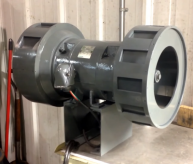
An original creation by CLM, the Type 927xxDP is a unique dual rotor rotating electromechanical siren, and is largely a CLM Type 5263 (mentioned below) siren with two horns and a rotator mechanism attached. It came exclusively in 10/12 port dual tone. The 10 port side has only 4 stator ports, a 10 port rotor, and its intake has a diamond shaped cover. Because of this, the 12 port side is significantly more audible than the 10 port side at a distance. However, the 10-port side is dominant near the siren, as the rear intake forces the sound downwards while the front horn projects the sound far away. The siren is driven by a bare dual sided 5 hp AC motor, which is attached to the rotator shaft by two tall brackets and a plate. The Type 927xxDP was claimed to output around 130 dB at 100 ft, although this claim is unconfirmed.
The CLM Rotational siren came in two models, the Type 92730DP (3 ph 220 V AC) and the Type 92729DP (3 ph 550 V AC). The rotational models are three phase only, and were never available in single phase.
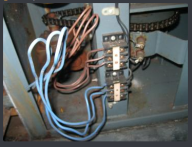
The rotator is powered by a separate 1/3 hp motor, with a vertical belt driven pulley attaching the motor to a gearbox below it, which then drives a chain-driven pulley rotating the siren at approximately 12 RPM, far faster than most rotating sirens. It is only beaten by the Swedish Electric Co. rotational sirens in default rotation speed, and is the fastest rotating siren with gear reduction. The fast rotation speed causes the siren's sound to waver significantly as it rotates, with each port becoming dominant as it faces the listener similarly to a Federal 500-DHTT.
The motor starter in the controller is configured by default to control both motors at once, meaning that the siren stops rotating immediately when the chopper motor shuts off. However, the rotator can be used independently of the rotor when directly using the controller. The rotator is housed inside of a tall rectangular housing, with two removable panels allowing access to the internals. The siren's collector rings and fuses are also located inside the housing. There are two handles which allow easy removal of the side panels, and four eyebolts are attached to each top corner of the siren to allow easy mounting with a crane.
Omnidirectional
CLM also produced a multitude of omnidirectional sirens, including:
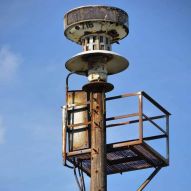
Type 92763CP
Another original creation, the Type 92763CP is a vertical omnidirectional siren that is essentially a Type 5263 in vertical form. The Type 92763CP was a vertical option that was designed to be used as part of a wider system, often supplementing Type 927xxDP rotational sirens by filling coverage gaps, although they were also occasionally used in their own systems. These bear a slight resemblance to the Federal SD-10, using two curved surfaces to help project the sound outwards, rather than using horns. The Type 92763CP uses a 3 hp AC electric motor, which was only available in 220 V single phase and drives a single 13.5 inch rotor. Unlike CLM's other sirens, this used a single rotor and stator rather than two split rotors. The rotor appears to be the Type 5263's rotors cast back to back as a single rotor. CLM rated this siren at 105 dB at 100 ft.
The siren has two intakes, with the top intake having a very large rainshield above it which also acts as the upper projector with an inverted cone, while the second intake is located below the rotor. The 12-port side is fed by the top intake while the 10-port side is fed by the lower intake. A large skirt is included under the stator, which serves to complete the two projector surfaces. The siren uses a rotor-over-motor configuration, with the siren's bare motor being located underneath the siren, unprotected from the elements. A mesh screen is included on both intakes to protect the rotor.
The Type 92763CP siren is very rare, with few in private possession and a handful in museums. Only one of these sirens is currently in active use, serving as a fire siren in Perth-Andover, NB.
Type 5261/Type 32164/Syren 2323
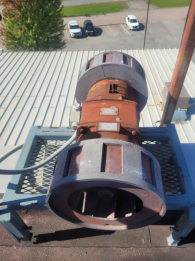
The Type 5261 was first created by Burlec-Carter, who later allowed CLM to replicate the design. Burlec's variant is known as the Type 32164, or Syren 5236. Burlec's design is identical to the 3 hp 5261.

This dual-rotor siren model was meant for use at fire stations and other areas where three-phase power may be too expensive or impractical to use. The Type 5261 uses a 3 or 5 hp 220 V brushed single phase motor operating at 3450 RPM, driving a pair of 13.5 inch rotors. Like CLM's other sirens, this siren was produced exclusively in 10/12 port dual tone. The siren is not centered on its base, as the motor is asymmetrical due to the inclusion of two access holes for brush and commutator maintenance.
The 5261 was available in two different variants under the same name, sharing the same motor shell and base. The first variant was directly based on the Burlec design and uses significantly thinner rotors than other CLM models, likely to reduce the load on the motor. This variant uses a 3 hp brushed motor, and has the weakest performance of CLM's dual rotor sirens. This variant is essentially a Type 5263 with a 5 hp brushed single phase motor instead of the usual induction motor, and was likely released later. The 5 hp variant is much less common than the 3 hp variant, as the 3 hp variant costed less to produce and purchase which made it more popular with volunteer fire departments and other places that lacked three phase power.
The Type 5261's single phase motor made it popular with volunteer fire departments and remote communities where three-phase power is not always readily available. and saw widespread use across Canada. Like most single phase sirens with brushed motors, the Type 5261 sometimes run into reliability issue as the brushes wear out and the siren can struggle to reach full pitch or waver with worn brushes. The Type 5261 is the most common CLM model found in the wild, with some still in service as fire sirens. At least two Burlec 2323 units still survive, one preserved in the Chilliwack Museum in Chilliwack, B.C and the other expected to return to fire siren service.
Type 5263/Syren 5236

The Type 5263 was first created by Burlec-Carter, who later allowed CLM to replicate the design. Burlec's variant is known as the Syren 5326. The Type 5263 is often called the "Mailbox" siren, as they are quite often found inside of specialized box-shaped housings to protect them from the elements.
The Type 5263 is a Carter-like dual tone siren that was CLM's standard siren offering. These are built very similarly to British air raid sirens, but these run at 60 Hz rather than 50 Hz which results in a higher pitch than sirens in the UK. The Type 5263 runs on a 5 hp dual-shaft AC motor, with one 13.5 inch 10-port rotor and stator and one 13.5 inch 12-port rotor and stator on each side, resulting in a 10/12-port siren. The Type 5263 was available in 220/550 V three phase only, though it could be ordered as the 5 hp variant of the Type 5261.
The Type 5263 forms the core of the Type 927xxCP rotational sirens, which are little more than Type 5263 units with a rotator, projectors, and a special 3-port rear stator placed on them.
These sirens are some of the least common surviving CLM models, with very few remaining in service or private possession. At least one Burlec 5236 survives in the Chilliwack Museum in Chilliwack, B.C.
Type 5223

Originally created by Burlec-Carter as early as 1943, the Type 5223 is a unique 20/24 port dual tone siren, which features two massive 26 inch rotors. The rotors on these sirens dwarf most siren rotors, and give the siren a distinct, unique appearance. The Type 5223 runs on a 5 hp dual-shaft AC electric motor, which is unique in that it runs at half the speed of most siren motors, at only 1625 RPM instead of ~3500 RPM. This is due to being a 4-pole motor. The Type 5223 was available in either 220 V or 550 V three-phase, with no single phase option. While early sirens such as the Denver sirens used half-speed 4-pole motors due to a lack of access to faster motors, full-speed 2-pole motors were already commonplace by the time the Type 5223 began production which makes this siren's design somewhat questionable. Because it has twice the ports of a regular 10/12 siren while running at half the motor speed, it sounds nearly identical to a 10/12 port siren.
The Type 5223 likely was not too popular, since it offered no advantages over a standard CLM Carter and was much heavier. These sirens tend to have longer coast times due to the size of their rotors. These sirens are often found on display or in private possession, and very few are known to currently be in service. Alvinston, Ontario's fire department plans to put their Type 5223 into service as a fire siren, though it remains inactive as of 2025.